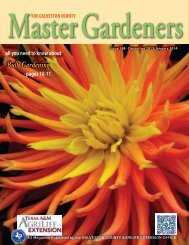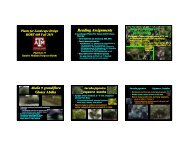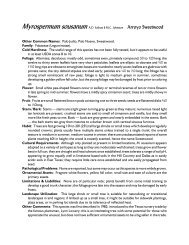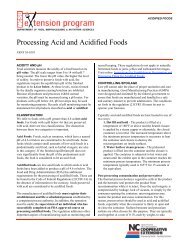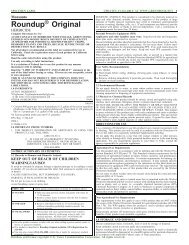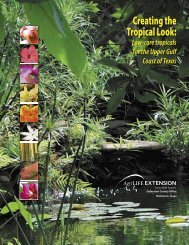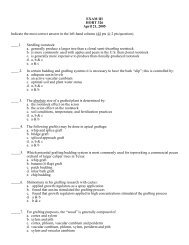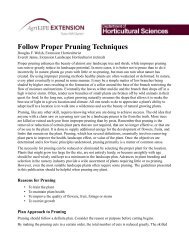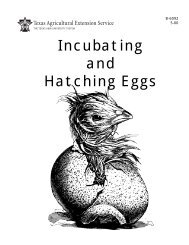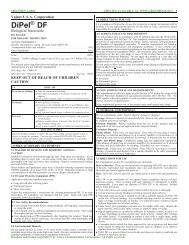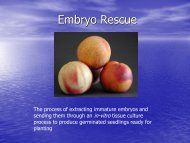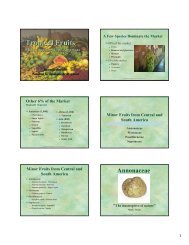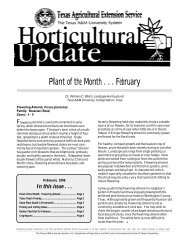Guide to PAS 2050 How to assess the carbon ... - Aggie Horticulture
Guide to PAS 2050 How to assess the carbon ... - Aggie Horticulture
Guide to PAS 2050 How to assess the carbon ... - Aggie Horticulture
Create successful ePaper yourself
Turn your PDF publications into a flip-book with our unique Google optimized e-Paper software.
34<br />
Section II: Calculating product <strong>carbon</strong> footprints<br />
Transport<br />
When <strong>the</strong> product is transported along with o<strong>the</strong>r<br />
products, transport emissions are allocated on <strong>the</strong><br />
basis of mass or volume, whichever is <strong>the</strong> limiting<br />
fac<strong>to</strong>r.<br />
For example, if 1 <strong>to</strong>nne of croissants is shipped in a<br />
2-<strong>to</strong>nne container along with 1 <strong>to</strong>nne of bread, <strong>the</strong><br />
croissants would be allocated 50% of <strong>the</strong> emissions<br />
associated with that transport leg.<br />
Reuse and remanufacture<br />
Total product life cycle GHG emissions, excluding <strong>the</strong><br />
use phase, are divided by <strong>the</strong> expected number of<br />
times <strong>the</strong> product is reused, including emissions<br />
associated with any remanufacturing required <strong>to</strong><br />
make it usable again. Then this figure is added <strong>to</strong> a<br />
single use phase’s emissions, resulting in a product<br />
footprint includes only a portion of <strong>the</strong> life cycle<br />
emissions, plus those from one full use phase.<br />
For example, if a tyre can be re-treaded up <strong>to</strong> four<br />
times over <strong>the</strong> course of its life, this creates five distinct<br />
use phases, four of which require a re-manufacturing<br />
step. To calculate <strong>to</strong>tal product GHG emissions over<br />
one life cycle:<br />
• Calculate all life cycle emissions excluding <strong>the</strong><br />
use phase – for simplicity say this comes <strong>to</strong><br />
100 g CO 2<br />
e<br />
• Add emissions from four re-manufacturing steps:<br />
assuming 25 g CO 2<br />
e per re-tread, for a <strong>to</strong>tal of<br />
4 × 25 = 100 g CO 2<br />
e; thus <strong>the</strong> <strong>to</strong>tal emissions<br />
over <strong>the</strong> full life of a tyre are 200 g CO 2<br />
e<br />
• Divide this by <strong>the</strong> anticipated number of uses:<br />
200/5 = 40 g CO 2<br />
e<br />
• Now add <strong>the</strong> use phase emissions from a tyre <strong>to</strong><br />
40 g CO 2<br />
e for <strong>the</strong> <strong>to</strong>tal emissions over one life<br />
cycle<br />
Now that <strong>the</strong> <strong>carbon</strong> footprint figure has been<br />
calculated, it is time <strong>to</strong> understand how precise and<br />
reproducible <strong>the</strong> measurement is. The next section<br />
explains this concept of uncertainty.<br />
Step 5: Checking uncertainty<br />
(optional)<br />
Uncertainty analysis in product <strong>carbon</strong> footprinting is a<br />
measure of precision. While not prescribed in <strong>PAS</strong> <strong>2050</strong>,<br />
companies can benefit from <strong>assess</strong>ing <strong>the</strong> uncertainty<br />
of <strong>the</strong>ir <strong>carbon</strong> footprint as described below – more<br />
detail on how <strong>to</strong> calculate uncertainty can be found in<br />
Appendix IV.<br />
The objective of this step is <strong>to</strong> measure and minimise<br />
uncertainty in <strong>the</strong> footprint result and <strong>to</strong> improve<br />
confidence in footprint comparisons and any decisions<br />
that are made based on <strong>the</strong> footprint. Uncertainty<br />
analysis provides several benefits:<br />
• Enables greater confidence in comparisons between<br />
products and in decision making<br />
• Identifies where <strong>to</strong> focus data collection efforts, and<br />
where not <strong>to</strong> focus<br />
• Contributes <strong>to</strong> better understanding of <strong>the</strong><br />
footprinting model itself – how it works, how <strong>to</strong><br />
improve it and when it is robust enough<br />
• If communicated it indicates robustness of <strong>the</strong><br />
footprint <strong>to</strong> internal and external audiences<br />
Best practice in product <strong>carbon</strong> footprinting, as<br />
encouraged by <strong>PAS</strong> <strong>2050</strong>, aims <strong>to</strong> minimise <strong>the</strong><br />
uncertainty in <strong>the</strong> footprint calculation <strong>to</strong> help provide<br />
<strong>the</strong> most robust, reliable and replicable result. <strong>PAS</strong> <strong>2050</strong><br />
does not explicitly require uncertainty analysis, although<br />
it may be necessary <strong>to</strong> meet data quality specifications.<br />
In practice, it is useful <strong>to</strong> delegate this task <strong>to</strong> someone<br />
experienced in uncertainty analysis and familiar with<br />
<strong>the</strong> product’s <strong>carbon</strong> footprint model.<br />
Reducing uncertainty<br />
Once sources of uncertainty have been identified<br />
through <strong>the</strong> process described in Appendix IV, <strong>the</strong>y can<br />
usually be reduced in <strong>the</strong> following ways:<br />
• Replace secondary data with good quality primary<br />
activity data, e.g. replace an estimated electricity<br />
consumption fac<strong>to</strong>r with actual measurements from<br />
a line sub-meter



